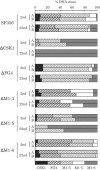Stable coexistence of five bacterial strains as a cellulose-degrading community
- PMID: 16269746
- PMCID: PMC1287685
- DOI: 10.1128/AEM.71.11.7099-7106.2005
Stable coexistence of five bacterial strains as a cellulose-degrading community
Abstract
A cellulose-degrading defined mixed culture (designated SF356) consisting of five bacterial strains (Clostridium straminisolvens CSK1, Clostridium sp. strain FG4, Pseudoxanthomonas sp. strain M1-3, Brevibacillus sp. strain M1-5, and Bordetella sp. strain M1-6) exhibited both functional and structural stability; namely, no change in cellulose-degrading efficiency was observed, and all members stably coexisted through 20 subcultures. In order to investigate the mechanisms responsible for the observed stability, "knockout communities" in which one of the members was eliminated from SF356 were constructed. The dynamics of the community structure and the cellulose degradation profiles of these mixed cultures were determined in order to evaluate the roles played by each eliminated member in situ and its impact on the other members of the community. Integration of each result gave the following estimates of the bacterial relationships. Synergistic relationships between an anaerobic cellulolytic bacterium (C. straminisolvens CSK1) and two strains of aerobic bacteria (Pseudoxanthomonas sp. strain M1-3 and Brevibacillus sp. strain M1-5) were observed; the aerobes introduced anaerobic conditions, and C. straminisolvens CSK1 supplied metabolites (acetate and glucose). In addition, there were negative relationships, such as the inhibition of cellulose degradation by producing excess amounts of acetic acid by Clostridium sp. strain FG4, and growth suppression of Bordetella sp. strain M1-6 by Brevibacillus sp. strain M1-5. The balance of the various types of relationships (both positive and negative) is thus considered to be essential for the stable coexistence of the members of this mixed culture.
Figures



References
-
- Barreiros, L., B. Nogales, C. M. Manaia, A. C. S. Ferreira, D. H. Pieper, M. A. Reis, and O. C. Nunes. 2003. A novel pathway for mineralization of the thiocarbamate herbicide molinate by a defined bacterial mixed culture. Environ. Microbiol. 5:944-953. - PubMed
-
- Briones, A., and L. Raskin. 2003. Diversity and dynamics of microbial communities in engineered environments and their implications for process stability. Curr. Opin. Biotechnol. 14:270-276. - PubMed
-
- Canstein, H. F., Y. Li, A. Felske, and I. Wagner-Döbler. 2001. Long-term stability of mercury reducing microbial biofilm communities analyzed by 16S-23S rDNA interspacer region polymorphism. Microb. Ecol. 42:624-634. - PubMed
Publication types
MeSH terms
Substances
Associated data
- Actions
LinkOut - more resources
Full Text Sources
Other Literature Sources
Molecular Biology Databases

